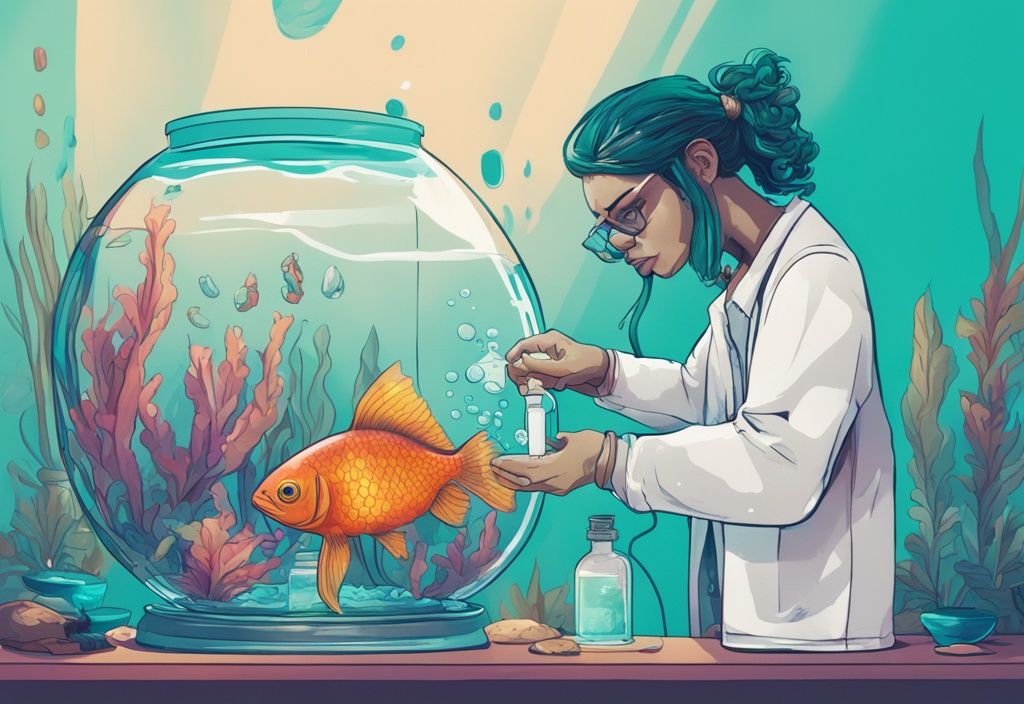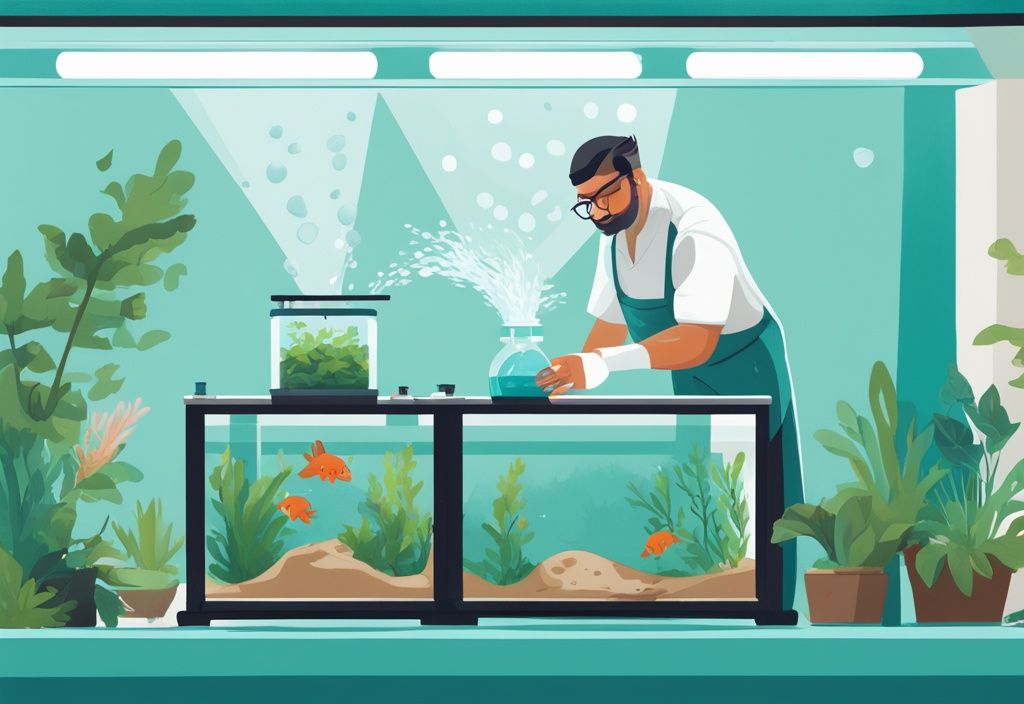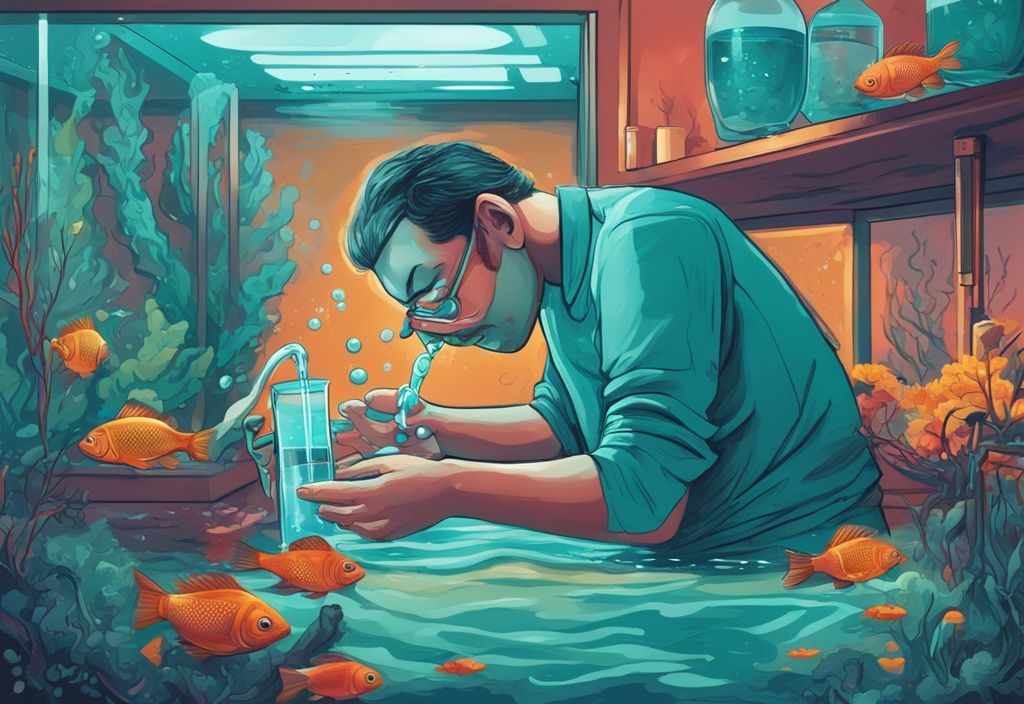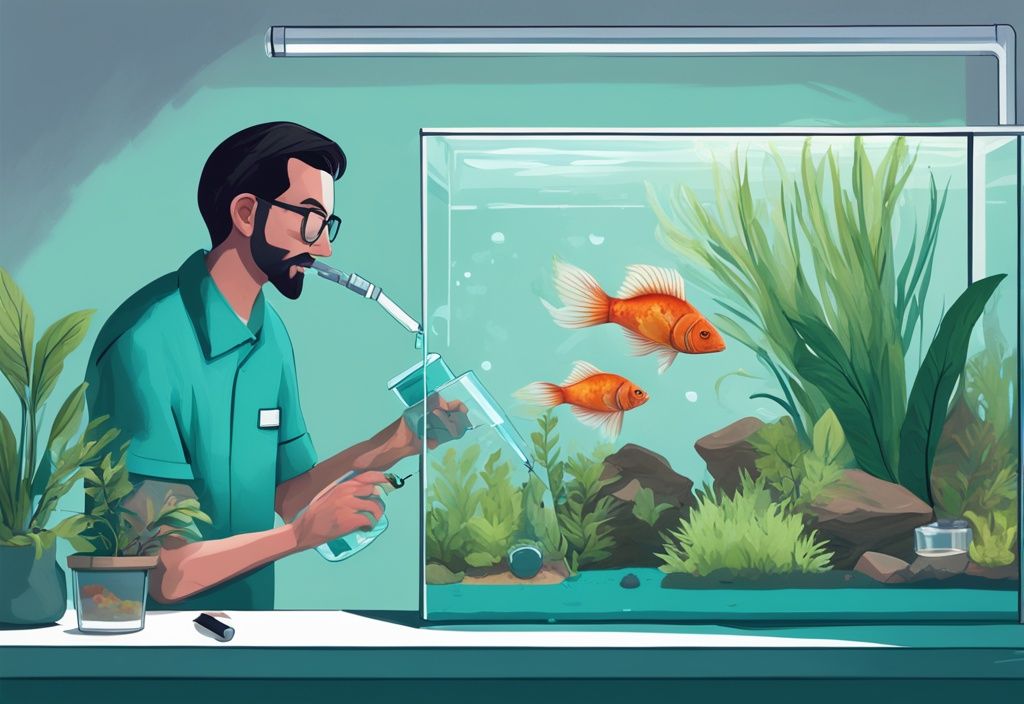Did you know that Nitrites are the invisible assassins in your fish tank, compounding their toxic presence over time? As a seasoned marine biologist, I’ve witnessed how these harmful compounds can stress your aquatic companions, leading to respiratory problems and even premature death. But worry not, this article offers reliable and swift solutions on how to lower nitrites in a fish tank, ensuring a safe haven for your underwater inhabitants.
It’s heartbreaking for any aquarist to see their fish in distress. That’s why I’ve put together this comprehensive guide. From seasoned pros to beginners in the aquarium world, you’ll discover practical, easy-to-understand steps to keep nitrite levels in check and promote a balanced, thriving ecosystem within your tank.
So, sit back, read on, and let’s dive into this life-saving mission of reducing nitrites, guaranteeing a healthier, happier underwater family for you.
Why Nitrites are Dangerous for Your Fish
Understanding What Nitrites are and Their Harmfulness
Nitrites (NO2-) are a toxic byproduct of the nitrogen cycle in an aquarium, originating from the breakdown of ammonia by beneficial bacteria. This compound can significantly harm your fish by disrupting their blood’s ability to transport oxygen, leading to a condition known as brown blood disease. This disease deprives fish of the essential oxygen needed for vital functions.
When nitrite levels rise, they induce considerable stress in fish, which is often visible through erratic swimming and color changes. The respiratory system is primarily affected as nitrites damage the gills, making it difficult for fish to breathe. If not managed promptly, elevated nitrite levels can be fatal. Understanding how to lower nitrites in a fish tank becomes imperative to ensure the well-being of your aquatic pets.
The Impact of High Nitrite Levels on Fish
Exposure to high nitrite levels leads to severe gill damage, hampering a fish’s natural ability to breathe efficiently. Fish struggling with nitrite toxicity may exhibit symptoms like gasping at the water’s surface, a clear sign of respiratory distress.
Additionally, nitrite poisoning can make fish lethargic and less active, indicating their overall discomfort. Over time, the persistent presence of high nitrite levels can weaken the immune system, rendering fish more susceptible to various diseases.
This combination of stress, respiratory problems, and compromised immunity calls for immediate action if elevated nitrite levels are detected. By frequently testing water parameters and implementing strategies for how to lower nitrites in a fish tank, such as regular partial water changes and effective filtration, Du can safeguard your fish from the detrimental impacts of nitrite toxicity.
Identifying the Causes of High Nitrite Levels
High nitrite levels in your fish tank can stem from various factors, each contributing to an unhealthy environment. Let’s delve into the common culprits and explore how to address them effectively.
The Role of Overfeeding in Increasing Nitrite Levels
One frequent cause of elevated nitrite levels is overfeeding.
Imagine you’re at an all-you-can-eat buffet—piling your plate high, only to realize you can’t finish it all.
Similarly, when fish are given more food than they can consume, the uneaten food decomposes, releasing ammonia into the water. This ammonia is then converted into nitrites by bacteria.
To maintain a healthy aquatic environment, it’s crucial to know how many fish in a fish tank is appropriate, as overstocking can lead to water quality issues.
To tackle this issue and lower nitrites in a fish tank, feed sparingly.
Provide only what your fish can eat within a few minutes. This simple adjustment prevents excess food from decomposing, reducing ammonia—and consequently, nitrite—levels.

The Problem of Overcrowding and Nitrite Accumulation
Overcrowding in your aquarium can contribute to high nitrite levels. Picture a cramped subway car at rush hour—too many bodies in too small a space. In your fish tank, an overcrowded environment means increased biological waste, which can overwhelm the tank’s processing capacity.
This leads to elevated ammonia and nitrite concentrations. For a balanced environment and to lower nitrites in a fish tank, ensure each fish has ample space. Stick to the recommended fish-per-gallon rule and avoid overpopulating your tank. This practice not only reduces nitrites but also promotes healthier, happier fish.
How Filtration Issues Contribute to Nitrite Spikes
Think of your tank’s filtration system as its respiratory system—it plays a pivotal role in maintaining water quality. Ineffective filtration is like a clogged airway, leading to the accumulation of waste products, including nitrites.
Biological filtration is essential for a healthy tank. Beneficial bacteria convert ammonia to nitrites and then to nitrates, which are less harmful. Regular maintenance and cleaning of filters and filter media are crucial steps to lower nitrites in a fish tank.
Ensure your filtration system is adequate for your tank size and bio-load. This ensures efficient waste processing, keeping nitrite levels in check and your aquatic ecosystem thriving.
Quick and Effective Ways to Reduce Nitrites
Managing nitrite levels in your fish tank is crucial for the health and well-being of your aquatic pets. This section covers various effective methods to lower nitrites, ensuring your fish tank remains a safe and thriving environment.
How Regular Partial Water Changes Lower Nitrites
Regular partial water changes are an essential strategy for lowering nitrite levels in your fish tank.
By removing 20-50% of the water weekly, you dilute the concentration of nitrites, minimizing their harmful impact on your fish.
Always use dechlorinated water during these changes to avoid killing beneficial bacteria vital for maintaining a balanced ecosystem. If you’re looking to enhance your aquarium environment, consider learning about the top plants suitable for fish tanks. Regular testing of your water with a reliable kit will help you determine when these changes are needed, ensuring your fish remain in a healthy environment.
Using Water Conditioners and Filter Media for Nitrite Reduction
Another effective method to lower nitrites in a fish tank is the use of water conditioners and specialized filter media. Products like SeaChem Prime can detoxify nitrites temporarily, providing immediate relief to your fish.
Additionally, incorporating special filter media designed to absorb nitrites and nitrates can significantly improve your tank’s overall water quality.
By adding nitrate-absorbing products, you can better control nitrite levels, creating a safer habitat for your aquarium inhabitants.

Controlling pH and Temperature for Optimal Nitrite Removal
Maintaining the right pH levels and stable temperature conditions plays a critical role in lowering nitrites in your fish tank. Optimal pH levels (around 7.0-8.0) support the growth of beneficial bacteria, which are essential for efficient biological filtration.
These bacteria help convert toxic nitrites into nitrates, a less harmful form. Avoid sudden temperature changes, as they can stress your fish and disrupt the nitrogen cycle, making it harder to control nitrite levels effectively.
Using Immediate Relief Nitrite Removing Products
For emergencies, using products specifically designed to provide immediate relief from high nitrite levels can be lifesaving. These nitrite detoxifying products work by binding the nitrites, rendering them less harmful to your fish quickly.
However, it’s important to understand that these solutions are temporary and should not replace regular maintenance and proper aquarium management practices. Combining these products with long-term strategies is the key to a thriving and healthy fish tank.
Long-term Strategies for Keeping Nitrite Levels Low
The Importance of Proper Aquarium Cycling
Proper aquarium cycling is essential to establish a stable environment that can efficiently process waste, thereby helping to lower nitrites in a fish tank. To learn more about the nitrogen cycle and how it impacts your aquarium, check out this detailed guide on the topic: https://www.aquariumcoop.com/blogs/aquarium/nitrogen-cycle?srsltid=AfmBOoqbXyzIeqmMjuBwxf7RNE7cuzRhlwnnBFODxZ1-bTWWmjOB7RKL. Cycling involves cultivating a colony of nitrifying bacteria that convert toxic ammonia, produced by fish waste and decaying organic matter, into nitrites, and subsequently into less harmful nitrates.
One effective method is the fishless cycle, where you introduce an ammonia source to the tank without any fish present. This avoids exposing fish to harmful ammonia and nitrites during the early stages. Adding pure ammonia or fish food to the tank will promote bacterial growth. Alternatively, starting with hardy fish species can also be viable, though this method requires more careful monitoring to prevent stress to the fish.
Throughout the cycling process, it’s essential to monitor ammonia, nitrite, and nitrate levels closely. Using a reliable test kit, measure these parameters regularly to track the progress of the cycle. Typically, the process can take several weeks, but patience pays off in the form of a balanced and healthy aquarium.
Tips for Regular Maintenance to Avoid Nitrite Spikes
Regular maintenance is crucial in managing and further lowering nitrites in a fish tank. To prevent detritus and uneaten food from decomposing and releasing ammonia into the water, it’s imperative to vacuum the substrate routinely. This practice removes waste particles that settle at the bottom and can contribute to nitrite production if left unchecked.
Cleaning decorations and rearranging tank contents periodically also helps prevent the build-up of debris and hidden waste pockets. This reduces the amount of organic matter that could potentially break down into ammonia and subsequently nitrites.
Another vital aspect of maintenance is ensuring adequate aeration. Increased aeration supports the oxygen levels necessary for the beneficial nitrifying bacteria to thrive and efficiently process nitrites. Air stones or additional filters can be used to boost oxygenation, facilitating a more effective nitrogen cycle.
By adhering to these regular maintenance practices, you ensure a clean and healthy environment, keeping nitrite levels consistently low and providing a safe haven for your fish.
FAQ: Answering Common Questions About Nitrites in Fish Tanks
Understanding nitrites in fish tanks can be quite challenging, yet crucial for maintaining a healthy aquarium. Below are some common questions and detailed answers to help you navigate through managing nitrite levels effectively.

How Long Does it Take to Lower Nitrites?
The duration to lower nitrites depends on a few factors, including the level of contamination and the steps you take to address it. If you diligently perform regular water changes and apply suitable treatments, you’ll often see a significant drop in nitrite levels within a few days. However, achieving a fully balanced aquarium could span several weeks to months. It’s like restoring harmony in a natural ecosystem—it doesn’t happen overnight, but with patience and the right care, balance can be achieved.
Can Nitrites Kill Fish Immediately?
Unfortunately, yes. Elevated nitrite levels can cause severe distress and even sudden death among fish, especially sensitive species. Implementing swift actions to lower nitrites in a fish tank becomes imperative when nitrite levels spike. Think of it as an emergency situation; the faster you respond, the better the chance of saving your aquatic friends.
Which Fish Species are More Tolerant to Nitrites?
While no fish thrive in high nitrite environments, species like Goldfish and certain Cichlids show a higher tolerance to temporary nitrite spikes. However, it’s a bit like having a high tolerance to smoke—continuous exposure still harms long-term health. Thus, striving to maintain the lowest possible nitrite levels in your fish tank remains essential for all species, even the hardier ones.
What are Safe Nitrite Levels for Fish Tanks?
Maintaining nitrite levels at 0 ppm is the ultimate goal for a thriving aquarium. Levels above 0.2 ppm may stress your fish, and anything exceeding 1 ppm could be outright dangerous. Therefore, regular testing is key to ensure your nitrite levels stay within safe boundaries. Think of it as health monitoring; just like how you check your own vitals regularly, your fish need the same kind of attention to ensure their well-being.
Conclusion
Ensuring a healthy fish tank environment hinges on the regular monitoring and regulation of nitrite levels. Elevated nitrite levels can pose severe risks to the well-being of your aquatic inhabitants, making it crucial for fish keepers to understand and implement effective strategies to mitigate this issue.
In the short term, implementing solutions such as water conditioners can provide immediate relief by detoxifying nitrites, offering a temporary safeguard for your fish. Regular partial water changes, utilizing dechlorinated water, play a pivotal role in diluting existing nitrites, thus bringing levels down swiftly. These proactive measures ensure that any spikes in nitrite levels are managed promptly and do not lead to adverse health effects for your fish.
Over the long term, adopting sustainable approaches is essential for maintaining a thriving aquarium. Proper aquarium cycling is fundamental in establishing a stable colony of nitrifying bacteria capable of converting harmful ammonia and nitrites into less harmful nitrates. Additionally, consistent aquarium maintenance practices, such as vacuuming substrates to remove waste and detritus, cleaning decorations to prevent debris buildup, and maintaining an effective filtration system, are indispensable. Ensuring adequate aeration and stable pH and temperature conditions further supports the biological processes that keep nitrites at bay.
For those struggling with algae issues, our guide on how to get rid of algae in a fish tank provides essential tips and techniques to maintain a clear and healthy aquarium.
By combining these short-term interventions with long-term maintenance and preventative measures, aquarium enthusiasts can effectively manage nitrite levels, ensuring a safe and vibrant environment for their fish. A well-regulated aquarium not only promotes the health and vitality of its inhabitants but also provides a more enjoyable and successful fishkeeping experience.
